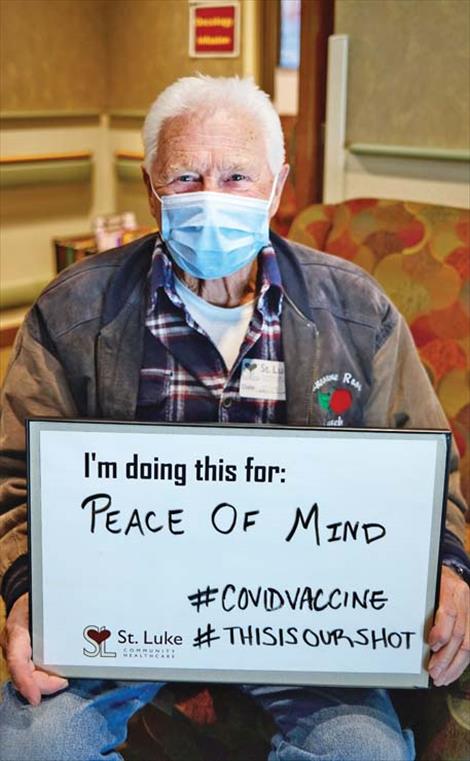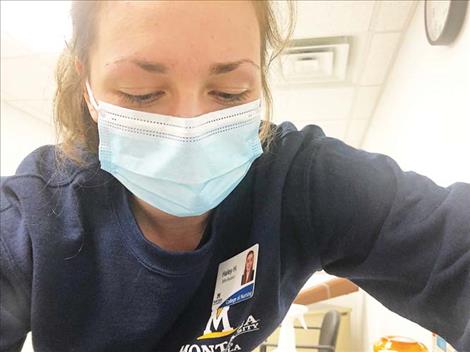COVID-19 vaccine dispersement continues, some hesitate
Hey savvy news reader! Thanks for choosing local.
You are now reading
1 of 3 free articles.
Brits accurately refer to shots as jabs. Well, I received my second jab Friday of the Moderna vaccine, and am already looking at my world with a rosier gaze.
As of Friday, I was one of 132,785 Montanans and more than 33 million Americans who are now fully immunized.
Happily, I had virtually no reaction second time around, unlike my sister, who had COVID-19 and was sidelined after each vaccination for about 24 hours. And unlike a pal, who breezed through the first round and spent “24 hours feeling sorry for myself” after the second injection.
Most folks I’ve talked to report little in the way of side effects either time, other than drowsiness, a sore arm or upset stomach. And all of them agree: it’s a small price to pay for liberation from a virus that’s kept kids out of school, businesses shuttered and family and friends apart for a year.
My friendly jabber Haley, a fourth-year nursing student at Montana State University, offered a few helpful tips: If you experience discomfort, take Tylenol, which is less apt to work against your immune system than Ibuprofen (my usual painkiller of choice); and hydrate well before and after the vaccine.
On a less helpful note: a grocery clerk recounted her conversation with someone who was certain that the COVID vaccines contain a lethal powder that will erupt and kill anyone who criticizes the government. With just a little research, I’ve concluded this is untrue. I’ve had two shots and so have most of my friends and family members and we all criticize the government regularly. Not one of us has died yet; however, misinformation abounds, and healthcare professionals do their best to offer respect, support and guidance to fearful or reluctant patients.
Erin Rumelhart, nursing director at Providence St. Joseph Medical Center in Polson, noted that those who resist getting the vaccine are typically concerned about its impact on their overall health and possible long-term effects.
“Our caregivers provide space to listen to their concerns, provide education if warranted and encourage the patient to reach out to their healthcare provider to discuss the best option for the individual patient,” she says.
Rumelhart emphasizes that vaccination “is very much a personal choice, which we as a hospital both honor and support.”
“Overall, the population we serve has been very receptive, grateful and hopeful when it comes to vaccination,” she adds.
Her counterpart at St. Luke Community Healthcare in Ronan, nursing director Abigail Byers, also notices some hesitancy among patients, “mostly regarding the timeline of the vaccine and wondering if it’s ‘too new’ to trust. We encourage everyone to make an educated decision by discussing questions with their primary care provider and seeking out information from trusted sources, including the Centers for Disease Control,” she says.
Both say misinformation about the vaccine is prevalent, especially from online sources and social media.
“We just do our best to share reliable information often,” says Byers. For the most part, she adds, St. Luke has witnessed “an overwhelmingly positive response” and is collecting and sharing stories via Facebook about why people are choosing to get vaccinated.
“Most recognize that this is the best way they can fight the pandemic and help protect those they care about,” she says.
Shots in arms
Vaccines continue to flow across Lake County, which as of Friday had dispersed 12,506 doses, with 8,025 going to first-timers. All told, 4,484 people are fully immunized out of an eligible population of 24,181.
On March 8, the state entered phase 1B+, which includes people 60 and older and those with certain medical conditions not included in phase 1B. Next up is phase 1C, which will include frontline essential workers, including teachers and first responders. Phase 2 will include all remaining Montanans 16 and older.
Pharmacies in each community are now a major vaccine source. At Credena Health Pharmacy Lakeshore (located inside Super One in Polson) longtime local pharmacist Ernie Ratzburg and head pharmacy tech Sonni Rosenbaum say demand is brisk.
The pharmacy receives between 300 and 400 doses of Moderna vaccine weekly and is scheduling around 30 shots a day Monday-Friday to first-timers (the remaining allotment is reserved for the second dose).
Like other suppliers, the pharmacy prioritizes vaccines on the basis of phases established by the state, including age group, health condition and occupation. They also keep a waiting list for those who aren’t in phases 1A, B or B+, in case they have cancellations.
Rosenbaum encourages people to sign up, even if they don’t meet current criteria. “There’s not a day that goes by when I haven’t pulled off that call list.”
“We don’t want to waste any, and so far, we haven’t had to waste a single dose,” she adds.
According to Ratzburg, they’ve already been able to vaccinate teachers and others with frontline exposure.
He asks that people who are on multiple lists notify other providers when they finally get a shot. “That would be really helpful,” he adds.
Here’s more information on how some of Lake County’s other primary vaccine distributors are faring in the effort to get shots in arms as quickly as possible.
CSKT Tribal Health
Undoubtedly, the tribes are a major reason Lake County is faring better than its neighboring counties in terms of vaccine distribution. Tribal Health receives 1,170 doses of the Pfizer vaccine every other week, thanks in part to the ultra-cold storage capacity at Salish Kootenai College. They also recently received 100 doses of Johnson and Johnson’s new single-dose vaccine.
By the end of last week, Tribal Health had given approximately 3,500 first doses during clinics at the Arlee Community Center and KwaTaqNuk Resort in Polson. An estimated 60 percent of tribal members over 70 have been fully vaccinated.
First doses are administered from one to three times a week
According to Chelsea Kleinmeyer, director of the Community Health Division, Tribal Health prioritizes vaccines for the following individuals:
— Anyone who identifies as American Indian
— Individuals living in a household with American Indians
— CSKT employees
— Teachers/educators on the reservation
Non-natives are also welcome to fill out the appointment request form at cskthealth.org. “We often pull from this when we have no-show spots that we need to fill,” she says.
As to the addition of educators to the list, “We are proud that the Tribal Council exercised their sovereignty and immunized educators a month before the rest of Montana,” says Kleinmeher. “And our teachers are so grateful!”
St. Luke Community Healthcare Network
Abigail Byers, director of nursing at St. Luke, reports that the vaccine supply has become “much more consistent,” with the hospital receiving an average of around 300 vaccines per week, and sometimes more. Like other providers, St. Luke has moved to phase 1B+, which includes ages 60 years and older and those 16-59 with medical conditions not included in Phase 1B.
The staff continues to vaccinate those in phases 1B (70 and older, and people with qualifying medical conditions) and 1A (healthcare providers and long-term care residents).
“We are hoping to move to phase 1C soon, but we’re following state guidelines and timelines,” she says.
The website, stlukehealthcare.org, remains the easiest and fastest way to sign up for the vaccine waitlist. However, the registration staff also assists by phone as needed.
The homepage now includes a “remove” button so those who have received the vaccine elsewhere can remove themselves from the waitlist. “This is very helpful and saves our scheduling staff a lot of time when making calls,” says Byers.
Staff also compares names against the state database, to see if someone has received the vaccine before calling them. Registrants are encouraged to carefully check all the information they enter online and make sure their voicemail is set up to receive messages.
“Our staff are making every effort to reach out to those on our list, but it is a long list and the process will take time,” she says. “If we all work together, this process will run smoothly.”
Next door at St. Luke Extended Care, 30 of the 37 residents are fully vaccinated and all have been offered the vaccine. One has received the first dose, and six have declined or were unable to receive the vaccine due to allergies, reports Social Services Director Andee Vassar.
With 81 percent of residents fully vaccinated, St. Luke is reviewing the revised nursing home visitation guidance from Centers for Medicare and Medicaid Services in preparation for opening the facility to visitors.
“It’s our goal to conduct visitation in the safest manner possible for our residents and their families,” says Vassar.
Providence St. Joseph
The Polson medical center is currently moving through phase 1B+ and will await the state’s go-ahead before moving to 1C.
According to Landon Godfrey, director of Hospital Operations, the portion of Lake County’s vaccine supply that’s split between St. Joseph, St. Luke and Lake County Public Health, “has been consistent and adequate based on the amount of patients in the initial phases.”
Those who contact St. Joseph are either scheduled for an appointment or placed on a waiting list, depending on which phase they qualify for.
At nearby St. Joseph Assisted Living, director Marion Cooper says 21 of the facility’s 27 residents who opted for the vaccine were fully vaccinated by Feb. 18, and on March 1, residents were able to visit with family and friends again.
Visitors must go through a screening process at the front door, and wear masks in the common areas of the facility. Residents are also allowed to attend church, go shopping, and visit family and friends outside of the facility.
St. Joseph continues to remains free of any active COVID-19 infections.

















